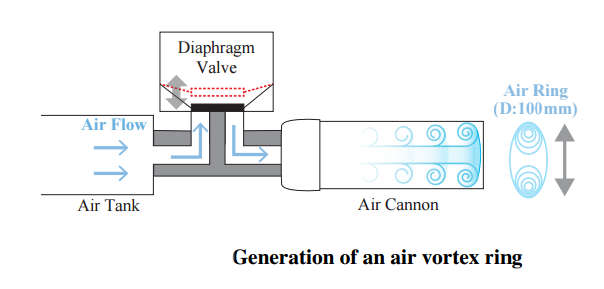| A Slap In The Face - A New UI? |
| Written by David Conrad | |||
| Saturday, 13 May 2017 | |||
|
Could an air cannon that fires vortex rings be the next big thing in the UI? Probably not but it is still worth seeing and there might well be applications that you can think up.
The ACM CHI Human-Computer Interactions conference usually throws up some oddball ideas - this is the whole point of research in this area. This year there are the usual handful of standout presentations, but there is one that tops the list -Investigating Haptic Perception of and Physiological Responses to Air Vortex Rings on a User's Cheek by Yuka Sato and Ryoko Ueoka. A while back there was a mild craze for a toy, usually called an airzooker or something similar, that would launch an air vortex ring. It had an elastic diaphragm that the user could snap and a tube that funneled the resulting shock wave into a rotating doughnut ring - like a smoke ring but without the smoke. What is really surprising is how stable this dynamic structure is. It can travel for tens of feet and still deliver enough energy to disrupt hair. It also travels fairly slowly and this often allows the perpetrator to escape. If you haven't tried one, take a look at this video from a famous toy shop of one in action:
Vortex guns can also be built using pumps and tubes and these are sometimes found at funfairs and attractions to spook out visitors.
In this case the spooking out is to see if an air vortex can be used as an output device: Haptic perception is one of the primary means of interaction with the world. Recent research on affective haptics suggests that it can affect emotional and behavioral responses. In this study, we evaluate user perceptions of haptic stimuli generated by air vortex rings on the cheek and investigate the effects on their physiological responses. To develop a cheek haptic display, we investigated and found that the cheek had enough resolution to perceive the differences in haptic stimuli in a two-point discrimination threshold test of the face. Additionally, the intensities of the haptic stimuli for experiments were determined by investigating the subjective impressions of different stimuli pairs. Finally, we conducted experiments to evaluate quantitatively the effects of four different combinations of haptic stimuli on the physiological responses in terms of stress modification, brainwave activities, task performance, and subjective assessment. The results suggest that different stimuli affect physiological responses and task performance
It may be all very serious but you can't help but think that building the vortex gun was fun, not to mention testing it out.
Before you get a little worried, I'm fairly sure that there is quite a lot of overacting going on and no humans were harmed, or even put to sleep in the course of these experiments. The vortex rings might be surprising, but they would have to be a lot more energetic before they did anything serious. Does this have any real world application? The researchers conclude: Given these results, we will revise the interactive air-vortexring haptic display for long-term experiments. By conducting a long-term experiment, we want to find out the varieties of haptic stimuli combinations that induce attention or relaxation depending on the user's situation. I can't say that I think that a vortex ring to the face will ever be relaxing, but I can see that there might be applications in communicating with remote users. For example, picking a lucky person out in a crowd or providing a warning to a worker at a distance from the computer. I can also see that it might make a great element in a game.
Of course I might be just saying these things so that I can justify my desire to build an air cannon and try it out. More InformationInvestigating Haptic Perception of and Physiological Responses to Air Vortex Rings on a User’s Cheek Related ArticlesPassive Haptic Learning - The No Effort Way To Learn A sticky touch screen improves interaction
To be informed about new articles on I Programmer, sign up for our weekly newsletter, subscribe to the RSS feed and follow us on Twitter, Facebook or Linkedin.
Comments
or email your comment to: comments@i-programmer.info
|
|||
| Last Updated ( Saturday, 13 May 2017 ) |




